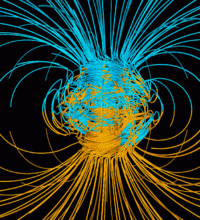
Photo from wikipedia
The paper describes quasi-periodic and aperiodic variations in the phase and amplitude of radio waves of LF and VLF ranges, which accompanied the flight and explosion of the Chelyabinsk meteoroid.… Click to show full abstract
The paper describes quasi-periodic and aperiodic variations in the phase and amplitude of radio waves of LF and VLF ranges, which accompanied the flight and explosion of the Chelyabinsk meteoroid. Quasi-periodic variations in the phase have been explained by the generation of acoustic-gravity waves in the atmosphere, which modulate the electron density in the ionosphere and the phase of radio waves. Aperiodic variations in the phase and amplitude of radio waves are associated with an increase in the electron density in the lower ionosphere (at altitudes of 65–70 km). This increase was most likely caused by the interactions of subsystems in the Earth–atmosphere–ionosphere–magnetosphere system or, more correctly, by the precipitation of high-energy electrons from the magnetosphere into the lower ionosphere, which was stimulated by the flight and explosion of a cosmic body. According to the estimates, the density of the flux of electrons with energies of 100 KeV should be on the order of 106 m–2 s–1.
Journal Title: Cosmic Research
Year Published: 2017
Link to full text (if available)
Share on Social Media: Sign Up to like & get
recommendations!